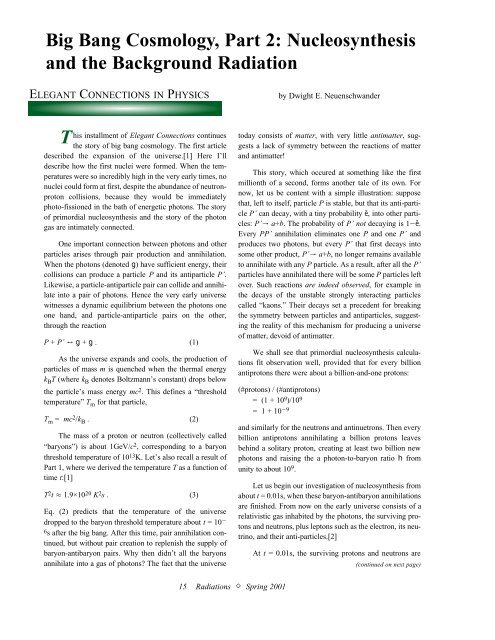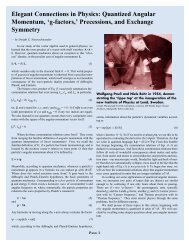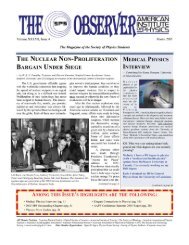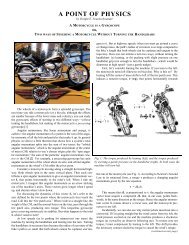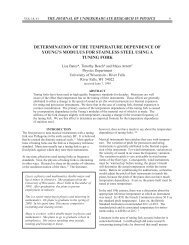Big Bang Cosmology, Part 2 - The SPS Observer
Big Bang Cosmology, Part 2 - The SPS Observer
Big Bang Cosmology, Part 2 - The SPS Observer
You also want an ePaper? Increase the reach of your titles
YUMPU automatically turns print PDFs into web optimized ePapers that Google loves.
<strong>Big</strong> <strong>Bang</strong> <strong>Cosmology</strong>, <strong>Part</strong> 2: Nucleosynthesis<br />
and the Background Radiation<br />
ELEGANT CONNECTIONS IN PHYSICS<br />
by Dwight E. Neuenschwander<br />
T<br />
his installment of Elegant Connections continues<br />
the story of big bang cosmology. <strong>The</strong> first article<br />
described the expansion of the universe.[1] Here I’ll<br />
describe how the first nuclei were formed. When the temperatures<br />
were so incredibly high in the very early times, no<br />
nuclei could form at first, despite the abundance of neutronproton<br />
collisions, because they would be immediately<br />
photo-fissioned in the bath of energetic photons. <strong>The</strong> story<br />
of primordial nucleosynthesis and the story of the photon<br />
gas are intimately connected.<br />
One important connection between photons and other<br />
particles arises through pair production and annihilation.<br />
When the photons (denoted g) have sufficient energy, their<br />
collisions can produce a particle P and its antiparticle P’.<br />
Likewise, a particle-antiparticle pair can collide and annihilate<br />
into a pair of photons. Hence the very early universe<br />
witnesses a dynamic equilibrium between the photons one<br />
one hand, and particle-antiparticle pairs on the other,<br />
through the reaction<br />
P + P’ E g + g . (1)<br />
As the universe expands and cools, the production of<br />
particles of mass m is quenched when the thermal energy<br />
k B T (where k B denotes Boltzmann’s constant) drops below<br />
the particle’s mass energy mc 2 . This defines a “threshold<br />
temperature” T m for that particle,<br />
T m = mc 2 /k B . (2)<br />
<strong>The</strong> mass of a proton or neutron (collectively called<br />
“baryons”) is about 1GeV/c 2 , corresponding to a baryon<br />
threshold temperature of 10 13 K. Let’s also recall a result of<br />
<strong>Part</strong> 1, where we derived the temperature T as a function of<br />
time t:[1]<br />
T 2 t 1.9×10 20 K 2 s . (3)<br />
Eq. (2) predicts that the temperature of the universe<br />
dropped to the baryon threshold temperature about t = 10 ⊗<br />
6 s after the big bang. After this time, pair annihilation continued,<br />
but without pair creation to replenish the supply of<br />
baryon-antibaryon pairs. Why then didn’t all the baryons<br />
annihilate into a gas of photons? <strong>The</strong> fact that the universe<br />
today consists of matter, with very little antimatter, suggests<br />
a lack of symmetry between the reactions of matter<br />
and antimatter!<br />
This story, which occured at something like the first<br />
millionth of a second, forms another tale of its own. For<br />
now, let us be content with a simple illustration: suppose<br />
that, left to itself, particle P is stable, but that its anti-particle<br />
P’ can decay, with a tiny probability ë, into other particles:<br />
P’O a+b. <strong>The</strong> probability of P’ not decaying is 1⊗ë.<br />
Every PP’ annihilation eliminates one P and one P’ and<br />
produces two photons, but every P’ that first decays into<br />
some other product, P’O a+b, no longer remains available<br />
to annihilate with any P particle. As a result, after all the P’<br />
particles have annihilated there will be some P particles left<br />
over. Such reactions are indeed observed, for example in<br />
the decays of the unstable strongly interacting particles<br />
called “kaons.” <strong>The</strong>ir decays set a precedent for breaking<br />
the symmetry between particles and antiparticles, suggesting<br />
the reality of this mechanism for producing a universe<br />
of matter, devoid of antimatter.<br />
We shall see that primordial nucleosynthesis calculations<br />
fit observation well, provided that for every billion<br />
antiprotons there were about a billion-and-one protons:<br />
(#protons) / (#antiprotons)<br />
= (1 + 10 9 )/10 9<br />
= 1 + 10 ⊗9<br />
and similarly for the neutrons and antinuetrons. <strong>The</strong>n every<br />
billion antiprotons annihilating a billion protons leaves<br />
behind a solitary proton, creating at least two billion new<br />
photons and raising the a photon-to-baryon ratio h from<br />
unity to about 10 9 .<br />
Let us begin our investigation of nucleosynthesis from<br />
about t = 0.01s, when these baryon-antibaryon annihilations<br />
are finished. From now on the early universe consists of a<br />
relativistic gas inhabited by the photons, the surviving protons<br />
and neutrons, plus leptons such as the electron, its neutrino,<br />
and their anti-particles.[2]<br />
At t = 0.01s, the surviving protons and neutrons are<br />
(continued on next page)<br />
15 Radiations ⋎ Spring 2001
about the same in number. <strong>The</strong>y can change back and forth<br />
into one another via the two-body collisions with leptons,<br />
p + e ⊗ E n + þ (4)<br />
and<br />
p + þ’ E n + e + . (5)<br />
<strong>The</strong>se reactions form examples of the “weak interaction,” a<br />
family of reactions that includes beta decay. Because the<br />
neutron’s mass is about 1.3MeV/c 2 greater than the proton’s,<br />
the neutron also beta-decays into a proton (plus an<br />
electron and an antineutrino):<br />
n O p + e ⊗ + þ’ . (6)<br />
We’ll neglect the reverse reaction of Eq. (6), because threebody<br />
collisions are rare compared to two-body ones.<br />
Let N n denote the number of neutrons and N p the number<br />
of protons, and let<br />
N n + N p = N . (7)<br />
In terms of the fractions X i = N i /N, Eq. (7) says<br />
X n + X p = 1 . (8)<br />
Let’s assume the ultra-relativistic gas of photons, leptons,<br />
and baryons in the early universe to be in thermal<br />
equilibrium. This means that the probability of a particle<br />
having energy E is proportional to the Boltzmann factor,<br />
exp(⊗E/k B T). All the particles are free, with energy E = K<br />
+ mc 2 , where K denotes the kinetic energy, which has the<br />
same average value for particles when the temperature T is<br />
uniform. Thus<br />
X n /X p = exp(⊗1.3MeV/k B T ) (9)<br />
Eqs. (8) and (9) may be united into<br />
X n = [1+ exp(⊗1.3MeV/k B T )] ⊗1 (10)<br />
from which we see that X n is determined by T. Eq. (10)<br />
holds so long as free neutrons and free protons form the<br />
only possible states of nuclear matter. Note that in the early<br />
portion of the epoch under consideration, when T is so large<br />
that 1/T is indistinguishable from zero, then X n X p ½.<br />
<strong>The</strong> collision-induced reactions of Eqs. (4) and (5)<br />
cease when the expansion of the universe had thinned the<br />
gas to the point that the leptons can no longer find the<br />
baryons. Of course, this diminishment of these collisions<br />
forms a statistical process, as do all processes we consider.<br />
But for the purpose of obtaining simple estimates of what<br />
occured, we can think of the cessation of reactions (4) and<br />
(5) as a sudden event. Its time and temperature occurs when<br />
the lepton-baryon collision rate drops below the expansion<br />
rate. <strong>The</strong> expansion rate is measured by Hubble’s parameter<br />
H, and the reaction rate follows from the details of the<br />
weak interaction. Let us calculate these rates.<br />
To calculate Hubble’s parameter, from Ref. 1 we recall<br />
one of the equations that describes the expansion of the universe<br />
(with zero cosmological constant):<br />
(dR/dt) 2 + k = (8pG/3c 2 )rR 2 (11)<br />
where H = (dR/dt)/R, with R the cosmic scale factor, G =<br />
Newton’s gravitational constant, r = the energy density of<br />
the universe, and k = the curvature parameter. At very early<br />
times, the particles all move at essentially the speed of light,<br />
so that the energy density is given by an extention of<br />
Stefan’s law, r = gsT 4 /c where gs 3.4×10 ⊗7 W/m 2 K 4<br />
when one takes into account only the electron, proton, neutron,<br />
neutrino, photon, and their antiparticles (g counts all<br />
spin degrees of freedom). In the very early universe, k is<br />
negligible even if k Þ 0, and we find<br />
H 2 = (8pG/3c 3 )gsT 4 .<br />
To estimate the rate G of reactions (4) and (5), imagine<br />
a baryon to be a target of cross-sectional area A. This is not<br />
necessarily the same area as the baryon’s geometric silhouette,<br />
because the interaction between the baryons and leptons<br />
has an energy-dependent range. Our baryon target<br />
moves at essentially the speed of light, so in time dt it<br />
sweeps out a cylinder of volume Acdt. <strong>The</strong> number of reactions<br />
it suffers with the leptons per unit time will therefore<br />
be the product of Ac and the number of leptons per unit volume<br />
n, or<br />
G = nAc . (12)<br />
From statistical mechanics, we learn from the Fermi-Dirac<br />
distribution the number density of ultra-relativistic leptons<br />
to be about (k B T/\c) 3 . From the “weak interaction” that<br />
describes Reactions (4) and (5), one learns that the crosssection<br />
A (G F k B T\c) 2 where G F = Fermi’s constant =<br />
10 ⊗5 GeV ⊗2 . From Eq. (12) we now have<br />
G = (k B T/\c) 3 (G F k B T\c) 2 c<br />
= G F 2 (k B T) 5 / \ . (13)<br />
When we equate the expansion rate to the reaction rate, G<br />
= H, Eqs. (11) and (13) yield T 1×10 10 K, which according<br />
to Eq. (2) occurs at t = 1.9s. By Eq. (10), we find that<br />
X n = 0.18 at this time.<br />
After 1.9s, the number of neutrons decreases, and the<br />
number of protons increases, thanks to the n O p decay of<br />
(continued on next page)<br />
16 Radiations ⋎ Spring 2001
Eq. (6). <strong>The</strong> half-life of the neutron is about 887s. Thus at<br />
times t > 1.9s, but before nucleosynthesis, the fraction of<br />
baryons that remain as neutrons declines according to<br />
X n = 0.18 exp[⊗(t⊗1.9s)/887s]. (14)<br />
<strong>The</strong> fraction of baryons that are protons grows as X p = 1⊗<br />
X n . This situation continues until protons and neutrons fuse<br />
to form stable nuclei. To that problem we turn next.<br />
FUSION TO HELIUM<br />
To build up the elements beyond hydrogen-1 requires<br />
the fusion of protons and neutrons. Before that can occur,<br />
the temperature must drop to a value where the photons,<br />
which outnumber the baryons by a billion to one, no longer<br />
have sufficient energy to photo-fission any newly formed<br />
nuclei.<br />
Nucleosynthesis begins when, for example, a proton<br />
and a neutron fuse to form a nucleus of hydrogen-2, the<br />
deuteron:<br />
Now the photon-to-baryon ratio is h = N g / (N n +N p ) = 10 9 ,<br />
and the neutron-to-baryon ratio is X n = N n /(N n +N p ). Thus<br />
Eq. (17) becomes<br />
v = X n / h = 10 ⊗9 X n . (18)<br />
Both v and X n are functions of temperature and thus the<br />
time, with X n given by Eq. (14). An evaluation of v follows<br />
from the Planck distribution for the thermodynamics of a<br />
gas of photons. This distribution describes the energy density<br />
dr g /dw of the photon gas in the frequency interval<br />
[w,w+dw]:<br />
dr g /dw = \w 5 /c 3 (2p) 3 [exp(\w/k B T)⊗1] ⊗1 . (19)<br />
A sketch of this distribution function is shown in Fig. 1. It’s<br />
the area under the curve for which \w ≚ 2.2 MeV that<br />
we’re after.<br />
n + p O 1 H 2 + g . (15)<br />
To build helium, the deuteron absorbs another proton to<br />
form a nucleus of helium-3 and a photon. <strong>The</strong>se reactions<br />
must happen twice before the next reaction can happen<br />
once: when two helium-3 nuclei collide, two protons are<br />
thrown off, leaving a nucleus of helium-4. So the overall<br />
reaction that begins with pn fusion and ends with a helium-<br />
4 nucleus is<br />
2n + 2p O 2 He 4 + 4 g . (16)<br />
<strong>The</strong> weak link in this chain of reactions exists in<br />
hydrogen-2, the deuteron. This nucleus provides the intermediate<br />
state towards building heavier nuclei (even when<br />
two protons fuse, one proton immediately turns into a neutron<br />
by emitting a positron and neutrino). But the deuteron<br />
is a fragile nucleus, with a binding energy of only 2.2 MeV.<br />
So with one neutron per deuteron, to avoid photofissioning<br />
the new deuterons, nuclear fusion must wait until the number<br />
of photons with energy greater than 2.2 MeV drops to<br />
less than the number of neutrons. Let v denote the fraction<br />
of photons having energies ≚ 2.2 MeV. <strong>The</strong>se photons are<br />
found out in the high-energy tail of the Planck distribution<br />
(see “blackbody” radiation in the textbooks). <strong>The</strong> number<br />
of photons with energies greater than 2.2 MeV will be vN g ,<br />
where N g denotes the number of photons, and thus our condition<br />
for the onset of nucleosynthesis becomes<br />
vN g = N n , (17)<br />
i.e., the fraction of photons with energy sufficient to photofission<br />
the deuteron equals the neutron-to-photon ratio.<br />
Fig. 1: <strong>The</strong> Planck distribution, showing the 2.2MeV tail of interest.<br />
To cut a long story short, we find that the temperature<br />
where all this happens is about 0.8×10 9 K, which by Eq. (2)<br />
corresponds to the time t = 297s. <strong>The</strong>n from Eq. (14) we<br />
find that at this time, the fraction of baryons that “freeze<br />
out” as neutrons is<br />
X n (297s)<br />
= 0.18 exp[⊗(297⊗1.9s)/887]<br />
= 0.13 (20)<br />
leaving 0.87 as the fraction of baryons that are protons.<br />
From this moment onward, the proton-to-neutron ratio<br />
stands at 0.87/0.13 = 6.7, which means that there are about<br />
134 protons for every 20 neutrons. Almost all of these neutrons<br />
will be bound into nuclei of helium-4, since no nuclei<br />
with five baryons are stable (the delay in leaping over fivenucleon<br />
nuclei allows the universe to expand and thin<br />
before much fusion can occur beyond helium). For simplic-<br />
(continued on next page)<br />
17 Radiations ⋎ Spring 2001
ity, let us assume that every neutron ends up in a helium-4<br />
nucleus.<br />
OK, let’s see: for every 134 protons there are 20 neutrons,<br />
for a sum of 154 baryons. <strong>The</strong>se 20 neutrons plus 20<br />
protons will make five nuclei of helium-4, consuming 40 of<br />
our 154 baryons.[3] Thus the fraction by mass of nuclear<br />
matter that is found in the form of helium-4 a few minutes<br />
after the big bang is 40/154 = 26%, leaving 114/154 = 74%<br />
of the nuclear mass as hydrogen-1 nuclei.<br />
To sum up so far: our simple calculations predict that<br />
of the nuclear matter emerging from the primordial fireball,<br />
about 26% by mass formed into helium-4, and about 74%<br />
as hydrogen-1. When astronomers survey the universe, taking<br />
into account the relatively small amount of elementbuilding<br />
that has occured after stars began to shine and<br />
supernova, they find the universe’s primordial chemical<br />
composition by mass to be about three-quarters hydrogen<br />
and one-quarter helium.[4] More realistic calculations[5]<br />
agree even closer with the empirical data; our simple model<br />
serves as an upper limit on the helium abundance.<br />
It is interesting to note that the problem was originally<br />
turned around: given an estimate of the observed abundances<br />
of the elements, George Gamow and others realized<br />
about 1948 that the very early universe must have been hot<br />
enough for photo-fission to prevent most baryons from<br />
being cooked into heavy nuclei.[6] <strong>The</strong>y used the abundances<br />
of the elements to predict the background radiation,<br />
the photon gas “afterglow” of the big bang itself.<br />
T HE B ACKGROUND R ADIATION<br />
Using arguments similar to those where we found the<br />
threshold temperature for deutron survival, one can also<br />
calculate the temperature below which electrons can remain<br />
in stable orbit (with binding energy 13.6 eV) around hydrogen<br />
nuclei without being instantly photoionized. This temperature<br />
turns out to be about 4000K, which happens about<br />
350,000 years after the big bang. From that moment<br />
onward, the universe becomes transparent to photons, and<br />
this photon gas continues to cool as the universe expands.<br />
Today, some 10 10 years later, this photon gas should have a<br />
temperature of just a few degrees above absolute zero, and<br />
be uniformly distributed throughout the universe. If the big<br />
bang really happened, then such a “background” radiation<br />
must exist. In 1965, two researchers working for the phone<br />
company with a microwave communications antenna, Arno<br />
Penzias and Robert Wilson, discovered this uniform background<br />
radiation.[7] Subsequently explored at other wavelengths,<br />
this radiation fits precisely a Planck distribution at<br />
a temperature of 2.735 K.<br />
This radiation’s temperature is uniform across the sky<br />
to four decimal places, as one would expect if it all came<br />
out of the same “oven” originally. However, small spatial<br />
fluctuations in the radiation’s temperature should exist for<br />
the following reason. In the early universe, matter and radiation<br />
were in thermal equilibrium. But today, matter is not<br />
uniformly distributed; on the scale of hundreds of millions<br />
of light years it appears as superclusters of galaxies. Hence<br />
the initial statistical fluctuations in density, which were<br />
amplified by the expansion into these clusters, should be<br />
imprinted on the radiation. <strong>The</strong> 1992 measurement to six<br />
decimal places by the COBE satellite confirmed these<br />
expected fluctuations, DT/T = 10 ⊗6 , a crucial vindication<br />
of the big bang model.[8]<br />
I NCLUDING O THER ELEMENTS<br />
Our derivation of the primordial element abundances is<br />
clearly over-simplified.[9] It is therefore important to<br />
appreciate what has been left out, which more realistic<br />
models must take into account.<br />
In general, one must include all species of nuclei, from<br />
bare protons and neutrons, through the isotopes of hydrogen<br />
and helium, lithium and beryllium, to isotopes of carbon<br />
and beyond. <strong>The</strong>se nuclei turn into one another through<br />
various collisions and radioactive decays. Consider nuclear<br />
species i, where N i /N = X i . Let us write a differential equation<br />
for the evolution of X i . Species i will be made by the<br />
reactions of other species j, so the increase in X i will be<br />
proportional to X j . At the same time, species i will diminish<br />
in proportion to X i , because when species i exists it can suffer<br />
collisions and decays that turn it into something else.<br />
Hence we may write<br />
d X i /dt = Sl(j Oi) X j ⊗ X i Sl(i O j) (21)<br />
j<br />
j<br />
where the l(i O j) are various reaction rate coefficients that<br />
have to be calculated and/or measured from elementary particle<br />
physics, nuclear physics, and statistical mechanics. An<br />
Eq. (21) exists for each nuclear species; hence a very large<br />
array of coupled differential equations, with time-dependent<br />
rate coefficients, must be solved: a considerable<br />
challenge!<br />
We have seen how, in our elementary calculation, we<br />
obtain a fairly robust prediction of the hydrogen-1 and helium-4<br />
abundances. <strong>The</strong>refore, the real mettle of the realistic<br />
calcuations comes in predicting the abundances of the other<br />
isotopes, which occur in minute trace amounts. I hope that<br />
our oversimplified model provides you with an appreciation<br />
of the skills of those who do the serious nucleosynthesis<br />
calculations!<br />
(continued on next page)<br />
18 Radiations ⋎ Spring 2001
****************<br />
NOTES<br />
[1] Elegant Connections in Physics, <strong>Part</strong> 1: <strong>The</strong> Expansion of the<br />
Universe, Radiations, Fall 2000. Eq. (2) and all other calculations<br />
shown in this Connections series on cosmology are faithful to the<br />
assumptions of our oversimplified pedagogical model (see Ref. 9).<br />
[2] We also ignore the heavier leptons (muon, tau), and the thermodynamic<br />
effects of neutrinos. <strong>The</strong>se effects must be included in<br />
any more realistic model.<br />
[3] Here we neglect the difference between the neutron and proton<br />
masses, and the difference between four proton masses and the<br />
helium-4 mass. <strong>The</strong>se differences amount to only a few parts out<br />
of a thousand.<br />
[4] K.A. Olive and G. Steigman, “On the Abundance of Primordial<br />
Helium,” Astrophys. J. Supp. 97, 49-85 (1995).<br />
[5] T.P. Walker, G. Steigman, D.N. Schramm, K.A. Olive, and H.<br />
Kang, “Primordial Nucleosynthesis Redux,” Astrophys. J. 3 7 6, 51-<br />
69 (1991); K.A. Olive, D.N. Schramm, G. Steigman, and T.P.<br />
Walker, “<strong>Big</strong>-<strong>Bang</strong> Nucleosynthesis Revisited,” Phys. Lett. B236,<br />
454-460 (1990). See also S. Weinberg, Gravitation and<br />
<strong>Cosmology</strong>, Ch. 15, Wiley (1972); John A. Peacock, Cosmological<br />
Physics, Cambridge (2000); B.W. Carroll, D.A. Ostlie, Modern<br />
Astrophysics, Addison-Wesley (1996). For a popular treatment see<br />
S. Weinberg, <strong>The</strong> First Three Minutes, Basic Books (1988).<br />
[6] G. Gamow, “Expanding Universe and the Origin of the<br />
Elements,” Phys. Rev. 7 0, 572-573 (1946); R.A. Alpher, H. Bethe,<br />
and G. Gamow, “<strong>The</strong> Origin of Chemical Elements,” Phys. Rev.<br />
7 3, 803-804 (1948).<br />
[7] A.A. Penzias and R.W. Wilson, Ap. J. 142, 419 (1965).<br />
[8] “COBE Measures Anisotropy in Cosmic Microwave<br />
Background Radiation,” Physics Today, p. 17-19 (June 1992).<br />
[9] Our treatment here is similar to B. Eskridge and D.<br />
Neuenschwander, “A Pedagogical Model of Primordial Helium<br />
Synthesis,” Am. J. Phys. 64, 1517-1524 (1996).<br />
⋎<br />
19 Radiations ⋎ Spring 2001


